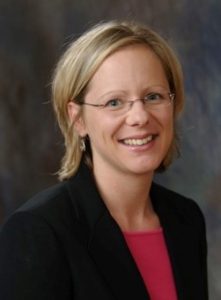Microstructure-induced Capillary Forces and their Role in Bone Regeneration
Speaker: Dr. Amy Wagoner Johnson, University of Illinois at Urbana-Champaign
Date: ; Time: 2:30 pm Location: BPB, room 131
 Abstract: More than 1.5 million people undergo bone graft procedures annually in the US to repair bone defects that will not heal spontaneously. These defects severely decrease the quality of life and are an economic burden to those affected and to the health care system. The already considerable demand for treatment is growing rapidly as the population ages and life expectancy increases. Allograft and autograft simply cannot adequately address the growing demand. The biggest technical and scientific challenge in treating these defects is in achieving complete osteointegration. There are promising approaches that combine scaffolds with exogenous cells and growth factors; however, these approaches are complex, expensive, and are still often considered to be too risky to the patient. New approaches that are safe, can be implemented in the near-term, and that could be applied to a range of scaffolds, and potentially even allografts, are needed. My research group focuses on manufacture, design, characterization, and application of CaP scaffolds with multiscale porosity. Our approach is to use capillary action to self-seed, or impregnate, CaP scaffolds that have multiscale porosity. We hypothesized that capillary force driven self-seeding would enhance bone regeneration. In vitro studies and a mathematical model showed that the micropore-generated capillarity generated was sufficient to draw in cells. Further, the penetration depth was dependent on cell size and stiffness, with some cell types penetrating further than others. In the subsequent in vivo study, samples that used capillarity, i.e. dry samples, were implanted and compared to two groups: wet and non-microporous (NMP). Wet samples were infiltrated with PBS prior to implantation such that they could not make use of capillarity. NMP samples did not contain microporosity and therefore had reduced capillarity. After three weeks, the average volume fraction of bone for all groups was the same across groups. However, the distribution of bone and the depth of bone growth were significantly better for dry samples compared to wet and NMP. The results have important implications in scaffold design, and use of this mechanism will help to address the challenge of repair of critical size bone defects in scaffold-based bone repair. Further, it will do so without the use of growth factors or exogenous cells.
Abstract: More than 1.5 million people undergo bone graft procedures annually in the US to repair bone defects that will not heal spontaneously. These defects severely decrease the quality of life and are an economic burden to those affected and to the health care system. The already considerable demand for treatment is growing rapidly as the population ages and life expectancy increases. Allograft and autograft simply cannot adequately address the growing demand. The biggest technical and scientific challenge in treating these defects is in achieving complete osteointegration. There are promising approaches that combine scaffolds with exogenous cells and growth factors; however, these approaches are complex, expensive, and are still often considered to be too risky to the patient. New approaches that are safe, can be implemented in the near-term, and that could be applied to a range of scaffolds, and potentially even allografts, are needed. My research group focuses on manufacture, design, characterization, and application of CaP scaffolds with multiscale porosity. Our approach is to use capillary action to self-seed, or impregnate, CaP scaffolds that have multiscale porosity. We hypothesized that capillary force driven self-seeding would enhance bone regeneration. In vitro studies and a mathematical model showed that the micropore-generated capillarity generated was sufficient to draw in cells. Further, the penetration depth was dependent on cell size and stiffness, with some cell types penetrating further than others. In the subsequent in vivo study, samples that used capillarity, i.e. dry samples, were implanted and compared to two groups: wet and non-microporous (NMP). Wet samples were infiltrated with PBS prior to implantation such that they could not make use of capillarity. NMP samples did not contain microporosity and therefore had reduced capillarity. After three weeks, the average volume fraction of bone for all groups was the same across groups. However, the distribution of bone and the depth of bone growth were significantly better for dry samples compared to wet and NMP. The results have important implications in scaffold design, and use of this mechanism will help to address the challenge of repair of critical size bone defects in scaffold-based bone repair. Further, it will do so without the use of growth factors or exogenous cells.
Biographical Sketch: Professor Amy Wagoner Johnson is an Associate Professor in the Department of Mechanical Science and Engineering (MechSE) at the University of Illinois at Urbana-Champaign, an inaugural faculty member of the new Carle Illinois College of Medicine, and a Chair of Excellence with the NanoSciences Foundation (Grenoble, France). Her research focuses on biomaterials and biomechanics, including soft tissue related mechanics to preterm birth and microstructural cues in CaP-based materials for bone regeneration. She received her BS in Materials Science and Engineering from The Ohio State University, and PhD in Engineering from Brown University in 2002 with major in materials science and minor in solid mechanics. She joined University of Illinois in 2001 as research faculty, became an Assistant Professor in 2005, and Associate Professor in 2012. She is currently a part-time faculty member of the Beckman Institute for Advanced Science and Technology, and has affiliations with the Department of Bioengineering, and Institute for Genomic Biology, where she is a Core Member of the Regenerative Biology and Tissue Engineering Theme.